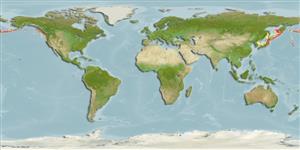Environment: milieu / climate zone / depth range / distribution range
Ecologia
marinhas batidemersal; intervalo de profundidade 257 - 1537 m (Ref. 27311). Temperate; 55°N - 35°N
North Pacific: Sagami Bay, Japan to the southern Kuril Islands and off Sakhalin, Russia.
Length at first maturity / Tamanho / Peso / Idade
Maturity: Lm ?, range 28 - ? cm
Max length : 44.0 cm SL macho/indeterminado; (Ref. 56407); common length : 26.4 cm SL macho/indeterminado; (Ref. 56407); peso máx. Publicado: 1.2 kg (Ref. 56527)
Descrição breve
Chaves de identificação | Morfologia | Morfometria
Espinhos dorsais (total) : 15 - 16; Raios dorsais moles (total) : 8 - 10; Espinhos anais: 3; Raios anais moles: 5; Vértebras: 27 - 30. Pectoral fin with notch, rays of lower lobe thick; head spine strongly and sharply produced; maxillary extending to middle of eye (Ref. 559). Body yellowish-red, a large black blotch on dorsal fin (Ref. 559).
Occurs in places with the steepest downthrow and sharp bends of sea bottom often in the places of the slope surrounded by large depths (the steep bottom relief causes vertical turbulent currents that provide the accumulation of food items) (Ref. 26289). Oviparous (Ref. 205). Eggs are extruded in floating gelatinous masses (Ref. 52092).
Eggs are enclosed in a gelatinous matrix which floats to the sea surface (Ref. 559). Females possess specialized ovarian structures including stalk-like ovigerous lamellae and secretory epithelia (Ref. 32832).
Robins, C.R., R.M. Bailey, C.E. Bond, J.R. Brooker, E.A. Lachner, R.N. Lea and W.B. Scott, 1991. Common and scientific names of fishes from the United States and Canada. Am. Fish. Soc. Spec. Publ. (20):183 p. (Ref. 3814)
Categoria na Lista Vermelha da IUCN (Ref. 130435)
Ameaça para o homem
Harmless
Utilização humana
Pescarias: espécies comerciais
Ferramentas
Relatórios especiais
Descarregue XML
Fontes da internet
Estimates based on models
Preferred temperature (Ref.
123201): 1.1 - 3.7, mean 2.5 °C (based on 89 cells).
Phylogenetic diversity index (Ref.
82804): PD
50 = 0.6250 [Uniqueness, from 0.5 = low to 2.0 = high].
Bayesian length-weight: a=0.00912 (0.00410 - 0.02027), b=3.09 (2.89 - 3.29), in cm total length, based on LWR estimates for this (Sub)family-body shape (Ref.
93245).
Nível Trófico (Ref.
69278): 3.2 ±0.40 se; based on food items.
Resiliência (Ref.
120179): Baixo, tempo mínimo de duplicação da população 4,5 - 14 anos (tm=10; Fec=69,355).
Fishing Vulnerability (Ref.
59153): High to very high vulnerability (69 of 100).
Nutrients (Ref.
124155): Calcium = 26.3 [11.3, 78.5] mg/100g; Iron = 0.377 [0.162, 0.807] mg/100g; Protein = 17 [15, 19] %; Omega3 = 1.05 [0.42, 2.83] g/100g; Selenium = 24.6 [10.1, 63.3] μg/100g; VitaminA = 27.3 [7.5, 101.4] μg/100g; Zinc = 0.607 [0.338, 0.980] mg/100g (wet weight);
